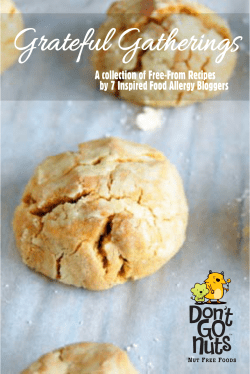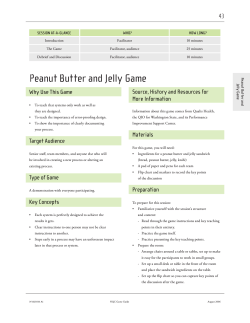
How to Read a Label for a Wheat-Free Diet
How to Read a Label for a Shellfish-Free Diet How to Read a Label for a Wheat-Free Diet All FDA-regulated manufactured food products that contain wheat as an ingredient are required by U.S. law to list the word “wheat” on the product label. The law defines any species in the genus Triticum as wheat. Avoid foods that contain wheat or any of these ingredients: bread crumbs bulgur cereal extract hydrolyzed wheat protein Kamut matzoh, matzoh meal (also spelled as club wheat couscous cracker meal durum einkorn emmer farina flour (all purpose, bread, cake, durum, pasta seitan semolina spelt sprouted wheat triticale vital wheat gluten wheat (bran, durum, germ, gluten, grass, matzo, matzah, or matza) enriched, graham, high gluten, high protein, instant, pastry, self-rising, soft wheat, steel ground, stone ground, whole wheat) malt, sprouts, starch) wheat grass whole wheat berries Wheat is sometimes found in the following: soy sauce starch (gelatinized starch, modified surimi starch, modified food starch, vegetable starch) How to Read a Label for an Egg-Free Diet All FDA-regulated manufactured food products that contain egg as an ingredient are required by U.S. law to list the word “egg” on the product label. Avoid foods that contain eggs or any of these ingredients: albumin (also spelled albumen) egg (dried, powdered, solids, white, yolk) eggnog globulin lysozyme mayonnaise meringue (meringue powder) ovalbumin ovovitellin surimi Wheat is sometimes found in the following: baked goods egg substitutes lecithin macaroni marzipan marshmallows nougat pasta All FDA-regulated manufactured food products that contain a crustacean shellfish as an ingredient are required by U.S. law to list the specific crustacean shellfish on the product label. Avoid foods that contain shellfish or any of these ingredients: crab crawfish (crayfish, ecrevisse) lobster (langouste, langoustine, scampo, coral, tomalley) prawn shrimp (crevette) Mollusks are not considered major allergens under food labeling laws and may not be fully disclosed on a product label. Your doctor may advise you to avoid mollusks or these ingredients: abalone clams (cherrystone, littleneck, pismo, quahog) cockle (pertwinkle, sea urchin) mussels octopus oysters snails (escargot) squid (calamari) Shellfish are sometimes found in the following: bouillabaisse cuttlefish ink fish stock seafood flavoring (e.g., crab or clam extract) surimi Keep the following in mind: Any food served in a seafood restaurant may contain shellfish protein due to cross-contact. For some individuals a reaction may occur from inhaling cooking vapors or from handling fish or shellfish. How to Read a Label for a Tree Nut-Free Diet All FDA-regulated manufactured food products that contain tree nut as an ingredient are required by U.S. law to list the specific tree nut on the product label. Tree nuts are sometimes found n the following: Avoid foods that contain eggs or any of these ingredients: almonds artificial nuts nangai nuts natural nut extract (e.g., almond, beechnut Brazil nuts butternut cashews chestnuts chinquapin coconut filberts/hazelnuts gianduja (a chocolate-nut mixture) nut butters (e.g., cashew butter) nut meal nut paste (e.g., almond paste) nut pieces nutmeat pecans pesto pili nut pine nuts (also referred to as Indian, ginkgo nut hickory nuts litchi/lichee/lychee nut macadamia nuts marzipan/almond paste pistachio praline shea nut walnuts walnut) pigñoli, pignolia, pignon, piñon, and pinyon nuts) Black walnut hull extract (flavoring) Natural nut extract Nut distillates/alcoholic extracts Nut oils (e.g., walnut oil, almond oil) Walnut hull extract (flavoring) Keep the following in mind: Mortadella may contain pistachios. There is no evidence that coconut oil and shea nut oil/butter are allergenic. Many experts advise patients allergic to tree nuts to avoid peanuts as well. Talk to your doctor if you find other nuts not listed here. © 2008 The Food Allergy & Anaphylaxis Network How to Read a Label for a Milk-Free Diet All FDA-regulated manufactured food products that contain milk as an ingredient are required by U.S. law to list the word “milk” on the product label. Avoid foods that contain wheat or any of these ingredients: butter, butter fat, butter oil, butter acid, butter ester(s) buttermilk lactulose casein casein hydrolysate caseinates (in all forms) cheese cottage cheese cream curds custard diacetyl ghee half-and-half lactalbumin, lactalbumin phosphate lactoferrin lactose milk protein hydrolysate pudding Recaldent® rennet casein sour cream, sour cream solids sour milk solids tagatose whey (in all forms) whey protein hydrolysate yogurt milk (in all forms, including condensed, derivative, dry, evaporated, goat’s milk and milk from other animals, low-fat, malted, milkfat, nonfat, powder, protein, skimmed, solids, whole) 11781 Lee Jackson Hwy. Suite 160 Fairfax, VA 22033-3309 Phone: 703-691-3179 Fax: 703-691-2713 www.foodallergy.org faan@foodallergy.org Milk is sometimes found in the following: artificial butter flavor baked goods caramel candies chocolate lactic acid starter culture and other bacterial cultures luncheon meat, hot dogs, sausages margarine nisin nondairy products nougat How to Read a Label for a Soy-Free Diet How to Read a Label for a Peanut-Free Diet All FDA-regulated manufactured food products that contain soy as an ingredient are required by U.S. law to list the word “soy” on the product label. All FDA-regulated manufactured food products that contain peanut as an ingredient are required by U.S. law to list the word “peanut” on the product label. Avoid foods that contain soy or any of these ingredients: Avoid foods that contain peanuts or any of these ingredients: edamame miso natto artificial nuts beer nuts cold pressed, expeller pressed, or extruded peanut oil goobers ground nuts mixed nuts soya soybean (curd, granules) soy protein (concentrate, hydrolyzed, isolate) shoyu soy sauce soy (soy albumin, soy cheese, soy tamari ice fiber, soy flour, soy grits, soy cream, soy milk, soy nuts, soy sprouts, soy yogurt) tempeh textured vegetable protein (TVP) tofu Soy is sometimes found in the following: Asian cuisine vegetable broth vegetable gum vegetable starch Keep the following in mind: The FDA exempts highly refined soybean oil from being labeled as an allergen. Studies show most allergic individuals can safely eat soy oil that has been highly refined (not cold pressed, expeller pressed, or extruded soybean oil). Most individuals allergic to soy can safely eat soy lecithin. Follow your doctor’s advice regarding these ingredients. monkey nuts nut pieces nutmeat peanut butter peanut flour peanut protein hydrolysate Peanut is sometimes found in the following: African, Asian (especially Chinese, egg rolls chili enchilada sauce mole sauce nougat Indian, Indonesian, Thai, and Vietnamese), and Mexican dishes baked goods (e.g., pastries, cookies) candy (including chocolate candy) Keep the following in mind: Mandelonas are peanuts soaked in almond flavoring. The FDA exempts highly refined peanut oil from being labeled as an allergen. Studies show that most allergic individuals can safely eat peanut oil that has been highly refined (not cold pressed, expeller pressed, or extruded peanut oil). Follow your doctor’s advice. © 2008 The Food Allergy & Anaphylaxis Network A study showed that unlike other legumes, there is a strong possibility of cross-reaction between peanuts and lupine. Arachis oil is peanut oil. Many experts advise patients allergic to peanuts to avoid tree nuts as well. Sunflower seeds are often produced on equipment shared with peanuts.
© Copyright 2025

















